Related Research Articles

Pokémon Ruby Version and Pokémon Sapphire Version are 2002 role-playing video games developed by Game Freak and published by The Pokémon Company and Nintendo for the Game Boy Advance. They are the first installments in the third generation of the Pokémon video game series, also known as the "advanced generation". After years of Nintendo being the sole publisher of the franchise in all regions, The Pokémon Company co-published the games for the first time since the establishment of the joint-owned company in 1998. They were first released in Japan in late 2002, and internationally in 2003. Pokémon Emerald, a third version, was released two years later in each region. Remakes of the two games, titled Pokémon Omega Ruby and Alpha Sapphire, were released for the Nintendo 3DS worldwide in November 2014, exactly twelve years to the date of the original Ruby and Sapphire release date, with the exception of Europe, where it released a week later.
The King of Fighters (KOF) is a series of fighting games by SNK that began with the release of The King of Fighters '94 in 1994. The series was developed originally for SNK's Neo Geo MVS arcade hardware. This served as the main platform for the series until 2004 when SNK retired it in favor of the Atomiswave arcade board. Two King of Fighters games were produced for the Atomiswave platform (The King of Fighters Neowave and The King of Fighters XI) before SNK decided to discontinue using it for the series. The series' most recent arcade hardware is the Taito Type X2, first used with the release of The King of Fighters XII. Ports of the arcade games and the original The King of Fighters games have been released for several video game consoles. The latest entry in the series, The King of Fighters XV, was released in February 2022.
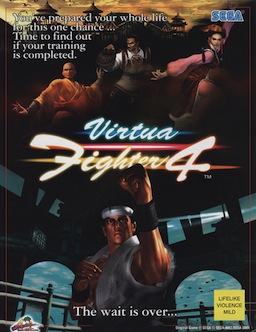
Virtua Fighter 4 is a fighting game by Sega. It is the fourth game in the Virtua Fighter series.

Double Dragon is a beat 'em up video game series originally developed and published by Technōs Japan. It began with the release of the arcade game Double Dragon in 1987. The series features twin martial artists, Billy and Jimmy Lee, as they fight against various adversaries and rivals.
Dead or Alive (DOA) is a media franchise based on a fighting game series developed by Team Ninja and published by Tecmo. It is primarily composed of fast-paced fighting games that began with the original Dead or Alive in 1996. The series received universal acclaim with the sequels Dead or Alive 2 in 1999 and Dead or Alive 3 in 2001, which are both considered landmark titles in the fighting genre and gaming. Dead or Alive is the creation of Tomonobu Itagaki, who developed the first four installments but has since left the company and is no longer working on the series, which continues without him.
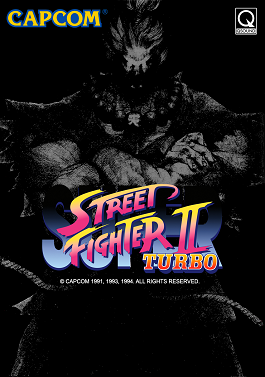
Super Street Fighter II Turbo is a fighting game released for the arcades by Capcom in Japan on February 23, 1994, in North America on February 23 and March 26, 1994 (beta) and in Europe in March 1994 (beta). It is the fifth installment in the Street Fighter II sub-series of Street Fighter games, following Super Street Fighter II: The New Challengers. Like its predecessor, it ran on the CP System II hardware.

MegaMan NT Warrior is an anime and manga series based on the Mega Man Battle Network series by Capcom, both using the same name but heavily diverging from each other in terms of plot. The manga series was written by Ryo Takamisaki and ran in Shogakukan's CoroCoro Comic between 2001 and 2006, while the anime television series, produced by Xebec, Nihon Ad Systems and TV Tokyo, ran for five seasons on TV Tokyo in Japan between March 2002 and September 2006, reaching 209 episodes in total, as well as a feature film. Viz Media would license the series for distribution in North America, including all the main chapters of the manga between 2004 and 2008, while the anime would only have its first season and Axess aired on Kids' WB! from 2003 to 2005.
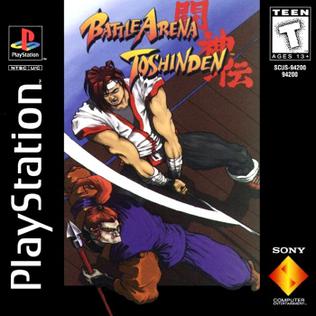
Battle Arena Toshinden, also transliterated Toh Shin Den, is a fighting video game developed by Tamsoft and published by Takara for the PlayStation. Originally released in 1995, it was released internationally by Sony Computer Entertainment, followed by 1996 ports for the Sega Saturn, Game Boy and MS-DOS. It was one of the first fighting games, after Virtua Fighter in 1993 on arcade and console, to boast polygonal characters in a 3D environment, and features a sidestep maneuver which is credited for taking the genre into "true 3D."
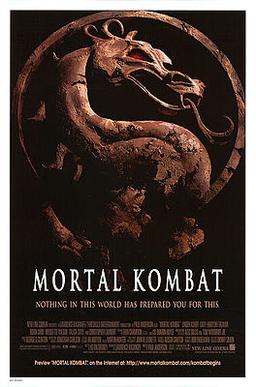
Mortal Kombat is a 1995 American fantasy action film directed by Paul W. S. Anderson and written by Kevin Droney. Based on the video game franchise of the same name, it is the first installment in the Mortal Kombat film series. Starring Linden Ashby, Cary-Hiroyuki Tagawa, Robin Shou, Bridgette Wilson, Talisa Soto, and Christopher Lambert, the film follows a group of heroes who participate in the eponymous Mortal Kombat tournament to protect Earth from being conquered by malevolent forces. Its story primarily adapts the original 1992 game, while also using elements from the game Mortal Kombat II (1993).
Street Fighter II: The Animated Movie, known as Street Fighter II Movie in Japan and Australia, is a 1994 anime film adaptation of the Street Fighter II fighting game written by Kenichi Imai, directed by Gisaburō Sugii and animated by Group TAC. The film, originally released in Japan on August 6, 1994, was released theatrically in the United Kingdom, France, and Spain, and was adapted into English in dubbed and subtitled format by Animaze for Manga Entertainment. It was distributed by Toei Company in Japan, while 20th Century Fox also distributed in other countries.
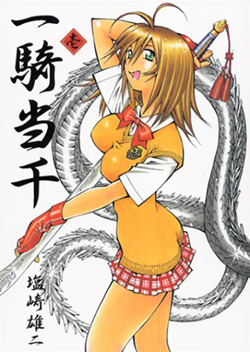
Ikki Tousen, also known as Battle Vixens in North America, is a Japanese manga series written and illustrated by Yūji Shiozaki. Loosely based on the classic 14th century Chinese novel Romance of the Three Kingdoms, the series revolves around an all-out turf war in the Kantō region of Japan where fighters known as Tōshi from seven schools battle for supremacy. The story centers on Hakufu Sonsaku, a fighter who transfers to Nanyo Academy, one of the seven schools involved in the turf war.
Culture Brain Inc. is a Japanese video game developer and publisher founded on October 5, 1980. In 2016, it was renamed Culture Brain Excel.

The King of Fighters '94 is a fighting game released by SNK for the Neo Geo MVS arcade system in 1994, as the first in The King of Fighters series. The game was also released for the Neo Geo home console systems, including the Neo Geo AES and Neo Geo CD. In 2008, KOF '94 was one of sixteen games included in SNK Arcade Classics Vol. 1 for the PlayStation 2, PlayStation Portable and Wii.
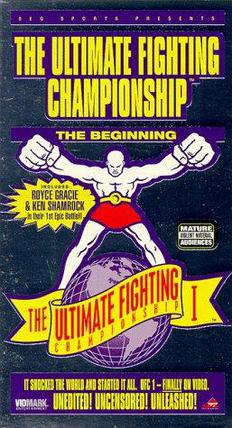
The Ultimate Fighting Championship was the first mixed martial arts event by the Ultimate Fighting Championship (UFC), held at the McNichols Sports Arena in Denver, Colorado, United States, on November 12, 1993. The event was broadcast live on pay-per-view and later released on home video.

Buffy the Vampire Slayer: Wrath of the Darkhul King is a 2003 video game developed by the Japanese company Natsume and published by THQ for the Game Boy Advance. It is an action platformer and the third of six video games based on the television show Buffy the Vampire Slayer. The game follows Buffy Summers, who fights vampires, demons, and other supernatural entities as the Slayer. Set in the show's fourth season, the story focuses on Buffy's attempt to prevent a demonic warlord from initiating an apocalyptic event. The player controls Buffy through 16 levels that focus on solving puzzles and defeating enemies by using customizable weapons.
Runecraft was a British video game developer based in the United Kingdom. The company was founded in April 1997 and mostly developed games based on licensed properties.

Kirby is an action-platform video game series developed by HAL Laboratory and published by Nintendo. The series centers around the adventures of a pink round hero named Kirby as he fights to protect and save his home on the distant Planet Popstar from a variety of threats. The majority of the games in the series are side-scrolling platformers with puzzle-solving and beat 'em up elements. Kirby has the ability to inhale enemies and objects into his mouth, spitting them out as a projectile or eating them. If he inhales certain enemies, he can gain the powers or properties of that enemy manifesting as a new weapon or power-up called a Copy Ability. The series is intended to be easy to pick up and play even for people unfamiliar with action games, while at the same time offering additional challenge and depth for more experienced players to come back to.
BBC Multimedia was a division of the BBC which dealt with the publishing of computer-game versions of well-known BBC television programmes.
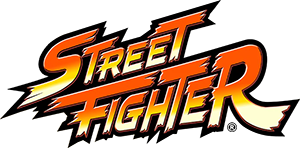
Street Fighter is a Japanese media franchise centered on a series of fighting games developed and published by Capcom. The first game in the series was released in 1987, followed by six other main series games, various spin-offs and crossovers, and numerous appearances in other media. Its best-selling 1991 release Street Fighter II established many of the conventions of the one-on-one fighting genre.
References
- ↑ "Goggle box gets 'Fightbox'". Edge . No. 124. Future Publishing. June 2003. pp. 6–7.
- 1 2 3 Yarwood, Jack (22 March 2023). "Remembering FightBox, BBC's Big-Budget Video Game Failure". Time Extension. Hookshot Media. Retrieved 23 March 2023.
- ↑ Calvert, Justin (7 January 2004). "BBC announces FightBox game". GameSpot . Fandom . Retrieved 23 March 2023.
- ↑ "BBC3's Fightbox on the ropes". The Guardian . 5 November 2003. Retrieved 23 March 2023.